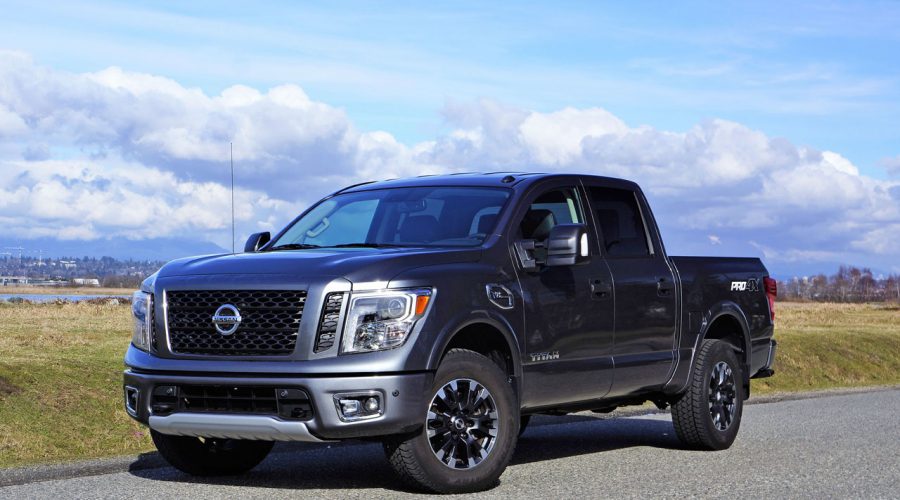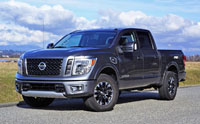
Stories about unprecedented pickup truck sales growth aren’t fully founded in reality, as shown by 2016 Canadian sales stats. Only Ford’s F-150 saw a big improvement last year, with 145,409 units out the door compared to just 118,837 in calendar year 2015, but it suffered from production issues that year. Toyota’s Tundra grew its numbers too, from 10,829 deliveries in 2015 to 11,364 in 2016, but compared to the blue oval, Toyota is clearly in the minor leagues when it comes to full-size pickups.
Last year’s losers include the Ram pickup that had its best year ever with 91,195 units in 2015 but fell to 89,666 sales in 2016 (nevertheless that’s its second-best-ever tally), whereas GMC Sierra deliveries dipped from 53,727 units in 2015 to 51,091 last year, Chevy’s Silverado sales dropped from 46,407 in 2015 to 44,932 in 2016, and believe it or not Nissan’s new Titan, which had 3,226 buyers in 2015 found only 2,715 last year, despite an entirely new model.
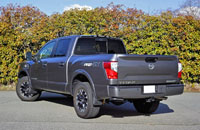
This dramatic downward drop wasn’t necessarily due to any reduction in interest, but more so a changeover to the new model (which required phasing out the old one) and the lack of a gasoline-powered version (only the new heavy-half “Extra Duty” Cummins diesel was available for 2016).
Incidentally, the full-size pickup truck sales scenario played out similarly in the U.S. last year, with all models south of the 49th moving up and down the sales chart just like here in Canada, except for the Ram pickup and Titan that gained in numbers and the Tundra that lost out.
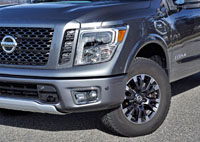
The Titan’s lack of gasoline power has been remedied for model year 2017, and the first four months of the New Year has improved for Japan’s alternative full-size truck brand here in Canada with 1,566 deliveries so far. If extrapolated throughout the year this number would grow to almost 4,700, resulting in the Titan’s best year ever (it’s previous high was 3,499 units in 2012), but we’d better not count these chickens before they’re hatched, as we know how that can turn out in the auto industry.
Still, there are a lot of reasons to be bullish about the new 2017 Titan, especially in standard trim. Those who like the look of the rugged new Titan XD will be happy Nissan kept its façade mostly unchanged with the standard truck, including its bold three-part rectangular grille, massive headlamp clusters, muscularly flared fenders, sporty side engine vents, and acres of chrome (depending on trim).
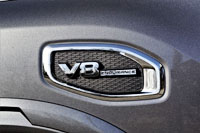
Actually, the $57,600 Crew Cab PRO-4X in our garage is the sportiest Titan variant, meaning much of its chrome has been swapped out for body-colour, matte black and satin aluminum, resulting in a look that’s much more sophisticated and (to these eyes) much more appealing. Along with the subdued glitter it gets a fabulous looking set of 18-inch machine-finished alloys with black painted pockets and (partial) spokes, these wrapped in 275/65 Toyo Open Country winters on my tester (although the standard 275/70 all-terrains would no doubt prove more capable off the beaten path).
Adding to the PRO-4X model’s trail trekking prowess are Bilstein off-road shocks, an electronic locking rear differential, hill descent control, transfer case and lower radiator skid plates, etcetera, while the interior gets metallic-tone interior accents, carpeted floor mats with PRO-4X logos, front bucket seats with special PRO-4X embroidery and a centre console in place of the standard bench, plus more.
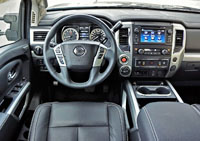
The standard Titan loses no size to the XD, with both near identical in length, width and height, depending on trim. The Regular Cab body style gets an eight-foot bed, whereas Crew Cab models utilize a five-and-a-half-foot bed. Nissan promises an extended cab model at a later date, but for now only the two cab and bed configurations are available.
I won’t go into detail about our tester’s cabin other than to say the $6,400 Luxury package makes for an impressive off-roader thanks to leather upholstery with white contrast stitching, front seat ventilation, a heatable steering wheel, heatable rear seats, a 360-degree Around View monitor, and remote start.
Our Crew Cab tester was outfitted with Nissan’s Utili-track Channel System with four load-securing tie-down cleats, standard with the PRO-4X, while integrated in-bed lockable boxes are also available. Even more important (depending on your height) is a new retractable Rear Bumper Step Assist system that aids access to the bed for only $399 (although standard with the PRO-4X), while available $1,029 step rails or $1,159 running boards would’ve been helpful too.
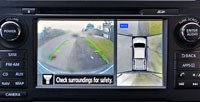
Standard PRO-4X exterior features not already mentioned include auto on/off headlights with signature LEDs, “Follow Me Home” functionality and integrated LED DRLs, plus fog lamps, LED under-rail bed and tailgate area lighting, heatable power-adjustable manually-extendable tow mirrors with integrated turn signals and puddle lights, rain-sensing wipers, front and rear parking sensors, blindspot monitoring with rear cross-traffic alert, a power-sliding rear window with a defroster, a factory-applied spray-on bedliner, a 110-volt power outlet in the bed, an electronic locking tailgate, rear utility bed steps, a Class IV tow hitch receiver with a four-pin/seven-pin wiring harness, trailer brake controller and trailer light check, and more.
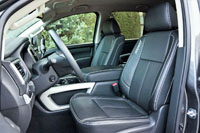
Proximity keyless entry with pushbutton ignition gets you inside, where you’ll be met by everything already noted as well as a leather-wrapped steering wheel, dual-zone automatic climate control, NissanConnect infotainment with a 7.0-inch touchscreen featuring a rearview camera, navigation, mobile apps, voice recognition, SiriusXM Traffic and Siri Eyes Free, Rockford Fosgate audio with 12 speakers and a sub, a centre console-mounted household-style 110-volt AC outlet, an eight-way powered driver’s seat with powered lumbar, heatable front seats, a lockable rear-seat cargo organizer, and much more.
The lighter weight regular Titan is an able ranch hand yet not quite the beast of burden of the XD, its maximum payload just 730 kilos (1,610 lbs) compared to the XD’s best 907-kilogram (2,000-lb) rating, and its top tow rating is 4,259 kg (9,390 lbs) instead of 5,443 kg (12,000 lbs). This comes down to a lighter duty chassis with unique spring rates, hubs, brakes, and more.
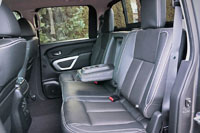
The only engine on offer in the regular Titan is Nissan’s Endurance 5.6-litre V8 capable of a generous 390 horsepower and 401 lb-ft of torque, which adds up to 73 more horsepower and 16 lb-ft of extra torque over the outgoing V8. This new engine is also found in Nissan’s 2017 Armada SUV (and its Infiniti QX80 counterpart), while all variations on the theme are partnered to the same seven-speed automatic transmission.
For comparison purposes, the Endurance 5.6-litre V8 matches up well against the Ram 1500’s 5.7-litre Hemi V8 and Toyota’s 5.7-litre Tundra V8, while it’s stronger than Ford’s 5.0-litre V8 and GM’s 5.3-litre V8.
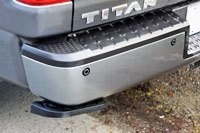
Four-wheel drive is standard on all but the base Titan Regular Cab S model, which incidentally starts at just $35,498. That price will likely go down when a V6 model is introduced, but so far we only have a promise from Nissan, with no release date.
As for fuel economy, the Titan Crew Cab achieves a claimed 15.2 L/100km in the city and 11.1 on the highway, whereas my PRO-4X tester is less frugal at the pump with a rating of 16.0 L/100km city and 12.0 highway.
I’ll include much more info as well as my driving impressions in an upcoming road test review, so stay tuned for more…

